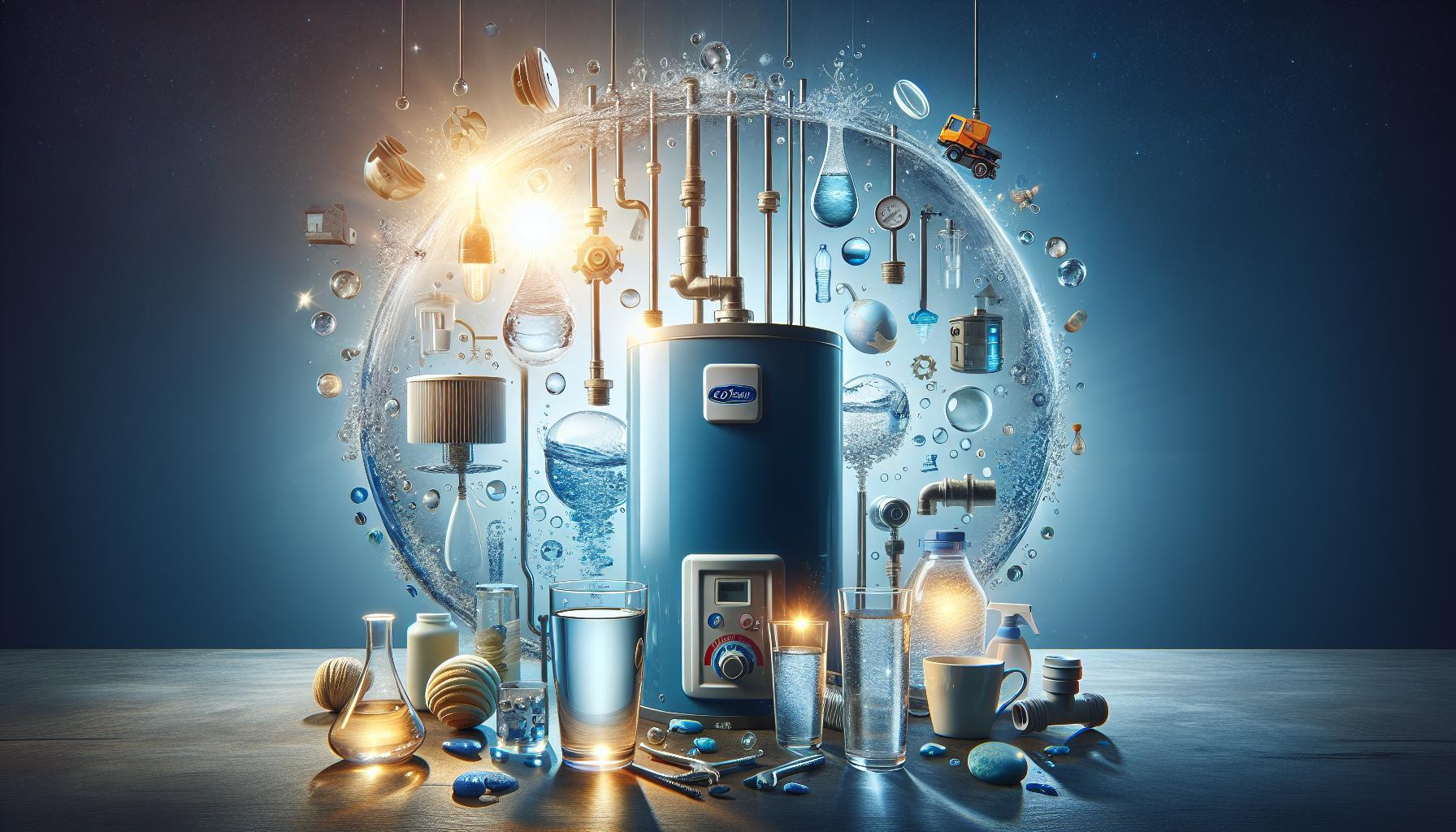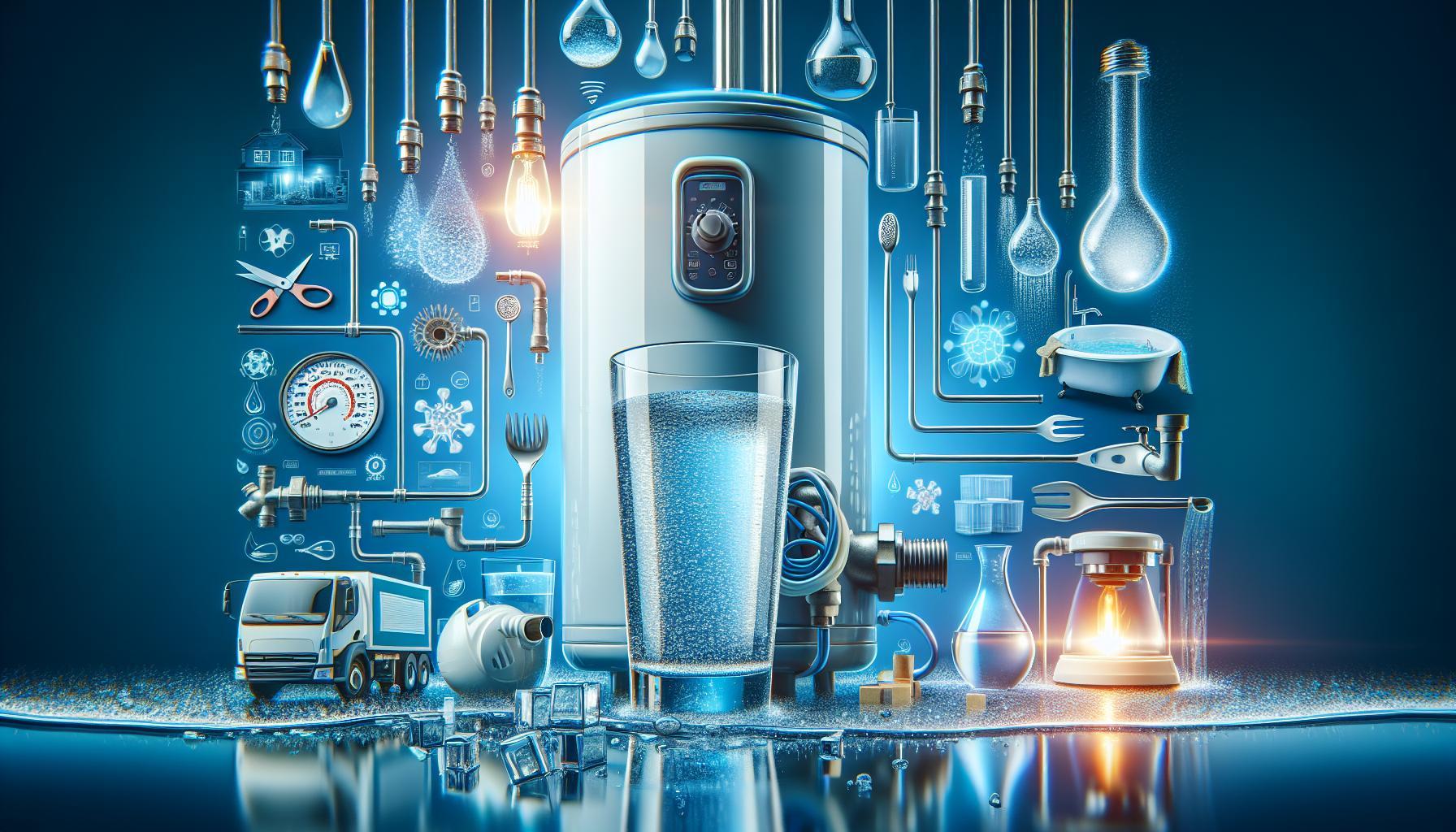Experiencing inconsistent hot water or unusual noises from your unit can be frustrating, especially when it disrupts daily routines. Understanding how to troubleshoot and replace the heating element in your A O Smith water heater is essential for maintaining efficiency and comfort in your home. This guide empowers you to tackle the issue confidently, ensuring reliable hot water flow.
Understanding the A O Smith Water Heater Element: How it Works
Understanding the mechanics of an A O Smith water heater element is essential for homeowners to maintain a consistent supply of hot water. Essentially, the element can be viewed as the heart of the water heater, responsible for heating the water to your desired temperature. When functioning properly, these elements can provide years of reliable service, but understanding how they work can also empower you to troubleshoot common issues and perform necessary replacements.
A O Smith water heaters typically use either electric or gas heating elements, depending on the model. The electric elements operate by passing electrical current through metal coils, generating heat that warms the water in the tank. In contrast, gas-fired systems rely on combustion, where gas burns to generate heat, which is then transferred to the water. Both types of systems must be monitored for efficiency, as problems can often arise from mineral buildup or component failure.
Common Issues and Solutions
Here are some common problems you might encounter with A O Smith water heater elements and their solutions:
- Insufficient Hot Water: This can be caused by a malfunctioning heating element. If the upper element is not working, the lower element will also struggle. Testing the elements with a multimeter can help determine which one needs replacement.
- Water Too Hot: If the thermostat is set too high or malfunctioning, it can lead to overheating. Adjusting or replacing the thermostat may be necessary.
- Strange Noises: Sounds such as popping or rumbling can indicate sediment buildup on the heating element, which decreases efficiency. Regular flushing of the tank can help prevent this issue.
When you face a heating element failure, refer to the components and specifications in the A O Smith Water Heater Element: Troubleshooting and Replacement Guide. This resource can provide detailed steps on how to securely replace the element and restore your water heater to optimal performance. Conducting regular maintenance checks and understanding your model’s specifications can significantly extend its lifespan and efficiency, saving you from costly repairs and ensuring a steady supply of hot water for your home.
In summary, familiarizing yourself with the A O Smith water heater element and its operation is not only beneficial for immediate troubleshooting but also essential for effective long-term maintenance. By applying the tips and knowledge gained from troubleshooting guides, you can enhance your expertise and possibly undertake repairs that can save time and money in the future.
Common Signs of a Failing Water Heater Element
A malfunctioning water heater can quickly turn from a mere inconvenience to a frustrating problem, especially when you rely on it for daily hot water needs. Understanding the is crucial for homeowners to take swift action before issues escalate. Noticing early symptoms can save you from costly repairs or an unexpected total replacement, so staying informed is key.
Recognizing the Symptoms
Several signs can indicate that your A O Smith water heater element is on the verge of failing. Paying attention to these warning signals can help you determine when to consult the troubleshooting advice or consider replacement. Here are some common symptoms to watch for:
- Inconsistent Water Temperature: If you find that your hot water supply has become inconsistent or fluctuates between hot and cold, it may point to a failing heating element.
- Strange Noises: Unusual sounds such as popping, rumbling, or hissing from your water heater can signal sediment buildup or that the heating element itself is malfunctioning.
- Water Temperature Not Reaching Desired Levels: When the water doesn’t reach the set temperature, there might be an issue with the heating element’s functionality.
- Leaks or Moisture Around the Unit: Noticeable water pooling or humidity around your water heater can suggest that the integrity of the element is compromised.
Additional Considerations for Troubleshooting
If you experience any of the above issues and suspect your water heater element may be failing, there are several steps you can take to troubleshoot before seeking professional help. Start with the following:
- Check the Power Supply: Ensure that the water heater is receiving power, as electrical issues can manifest similarly to element failures.
- Inspect the Thermostat Settings: Sometimes, incorrect thermostat settings can lead to inconsistent water heating. Verify that your settings match your hot water needs.
- Flush the Tank: Regular maintenance is essential; flushing the tank can help eliminate sediment buildup, which can significantly affect performance.
By promptly addressing these signs and conducting basic troubleshooting, you’ll be better prepared to decide whether to replace the element or consult the full guidance in “A O Smith Water Heater Element: Troubleshooting and Replacement Guide.” Recognizing these indicators early not only maximizes your appliance’s efficiency but also extends its lifespan.
Step-by-Step Troubleshooting: Diagnosing Issues with Your Element
When faced with issues related to your A O Smith water heater element, knowing how to methodically diagnose the problem can save you time and money. The troubleshooting process primarily revolves around understanding the symptoms and taking systematic steps to identify the root cause. Symptoms might include insufficient hot water, no hot water, or abnormal noises. By following a structured approach, you can effectively troubleshoot these problems.
Gathering the Necessary Tools
Before diving into the troubleshooting process, ensure you have the right tools on hand. Common tools needed include:
- Multimeter for electrical diagnostics
- Screwdriver for accessing the heater panel
- Insulation resistance tester
- Water pressure gauge
Having these tools ready helps streamline the diagnostic process, allowing you to check various components of the water heater quickly.
Initial Checks
Start with some basic checks that can reveal common issues before you delve deeper into the heater’s components:
- Power Supply: Ensure the unit is receiving power. Check for tripped circuit breakers or blown fuses.
- Thermostat Settings: Verify that the thermostats are set to the desired temperature.
- Water Supply: Check if the water inlet valve is fully open and if there are any noticeable leaks in the plumbing.
These initial steps might resolve your issue without further investigation, saving considerable time.
Testing the Heating Elements
If the basics are sound but problems persist, the heating elements themselves may be faulty. Here’s how to test them:
- Turn off the power supply to the water heater to avoid electrical shock.
- Remove the access panels on the tank.
- Use a multimeter to check the resistance of the heating elements. An operational element should typically show a resistance between 10 to 30 ohms.
- If the reading is infinite (open circuit) or zero (short circuit), the element likely needs replacement.
This hands-on troubleshooting can pinpoint whether an element is the source of the issue, as outlined in the comprehensive A O Smith water heater element troubleshooting guide.
Conclusion and Next Steps
If the heating elements are functioning correctly, but the unit still fails to produce hot water, next steps include examining the thermostat and other electrical components like wiring and connections. Sometimes, issues may stem from more complex electrical or plumbing systems that require professional assistance. Thus, while DIY troubleshooting can address many common problems efficiently, don’t hesitate to reach out to a professional when necessary. This thorough yet practical approach ensures that your A O Smith water heater continues to operate effectively and efficiently.
Tools and Materials Needed for Water Heater Element Replacement
When it comes to maintaining the efficiency of your water heater, understanding how to replace an element proactively can save both time and money. If you’ve found yourself referring to the ‘A O Smith Water Heater Element: Troubleshooting and Replacement Guide,’ you are likely aware of the importance of having the right tools and materials on hand. Knowing what you need before embarking on this task can streamline the process and make it less daunting.
Essential Tools
To successfully replace the heating element in your A O Smith water heater, you will require a few essential tools to ensure a smooth operation:
- Socket wrenches: A 1 1/16-inch socket is usually necessary for the element itself, while a ratchet or a larger socket set may also be helpful.
- Screwdriver: A flathead screwdriver can assist with loosening any screws on the access panel covers.
- Voltage tester: This tool is crucial for verifying that the power to the water heater is off before you start working.
- Pipe wrench: If your elements are particularly tight, a pipe wrench can provide the extra grip needed to unscrew them.
- Bucket: A bucket will catch any water that spills out when you remove the heating element.
Necessary Materials
Aside from tools, having the right materials can make your replacement efforts more effective. Here’s what you’ll need:
| Material | Purpose |
|---|---|
| New heating element | Required for the actual replacement; ensure compatibility with A O Smith models. |
| New gasket or sealing tape | Prevents leaks when installing the new element. |
| Water heater element wrench | Designed specifically for easy removal and installation of heating elements. |
| Anti-corrosion compound | Can be applied to threads to extend the lifespan of the new element. |
Ensuring that you have the appropriate tools and materials can significantly improve the efficiency and safety of replacing your water heater element. Not only will this preparation help you follow the guidelines in the ‘A O Smith Water Heater Element: Troubleshooting and Replacement Guide,’ but it will also empower you to tackle any unexpected challenges along the way, transforming a potentially overwhelming task into a manageable home maintenance project.
A Simple Guide to Replacing Your A O Smith Water Heater Element
When your A O Smith water heater stops producing hot water, the culprit may be a faulty heating element. Understanding how to troubleshoot and replace this component is crucial for restoring comfort in your home. The process can seem daunting, but with the right tools and guidance, homeowners can tackle this task with ease.
Gather Your Tools
Before diving into the replacement process, ensure you have all the necessary tools on hand. You’ll need:
- New heating element – Compatible with your A O Smith model.
- Multimeter – For testing electrical components.
- Screwdriver – Typically a flathead or Phillips, depending on your model.
- Wrench – To help loosen the old element.
- Towels – For any spills and to protect your floor.
- Safety gear – Including gloves and goggles.
Steps for Replacement
Follow these straightforward steps to ensure a successful replacement of your A O Smith water heater element:
- Turn Off Power: Always start by switching off the power to the water heater at the main circuit breaker to prevent any electric shocks.
- Drain the Tank: Attach a hose to the drain valve at the bottom of the tank and drain enough water to lower the level below the heating elements. This will help minimize any mess and ensure safety.
- Remove the Access Panels: Use your screwdriver to remove the panels covering the heating element. For models with insulation, you may need to set it aside carefully.
- Test the Element: With your multimeter, check the heating element for continuity. A lack of continuity indicates a need for replacement.
- Unscrew the Old Element: Using a wrench, carefully unscrew and remove the faulty element from the tank.
- Install the New Element: Position the new element in place and tighten it securely with the wrench. Ensure there are no leaks or loose connections.
- Reassemble: Replace any insulation and access panels once you are confident the element is securely in place.
- Refill and Power Up: Turn on your water supply and allow the tank to fill. Once it’s full, restore the power at the circuit breaker.
Testing for Success
After replacing your A O Smith water heater element, it’s essential to test if it’s functioning correctly. Turn on a hot water faucet and monitor the water temperature after a few minutes. If you notice significant improvements in hot water availability, congratulations! You’ve successfully replaced the heating element. However, if issues persist, consult the comprehensive A O Smith water heater element troubleshooting guide for further diagnostic steps.
By following these practical steps, you can not only save money on professional repairs but also gain valuable hands-on experience with home maintenance. Each successful repair bolsters your confidence, making you more adept at handling household challenges in the future.
Safety Precautions: What to Know Before You Get Started
When engaging in maintenance or repairs for your A O Smith water heater, understanding safety precautions is crucial to ensure a secure and efficient process. Appliance-related tasks can often involve risks, including electrical hazards and physical injuries. Proper preparation and awareness of these dangers can help you avoid accidents and ensure a smooth troubleshooting or replacement experience.
Essential Safety Guidelines
Before you begin the process, consider the following safety measures to protect yourself and your home:
- Power Down: Always turn off the power supply to the water heater before starting any work. This prevents potential electrical shocks.
- Water Supply Shutdown: Shut off the water supply to avoid leaks and flooding during the replacement or troubleshooting process.
- Wear Protective Gear: Utilize safety goggles and gloves to safeguard against splashes and sharp components. This is especially important when handling heated elements.
- Use Proper Tools: Ensure you have the necessary tools on hand, such as wrenches and screwdrivers, suited for your specific model of A O Smith water heater.
- Consult the Manual: Always refer to the water heater’s user manual for specific safety guidelines related to your model. Each unit may have distinct requirements.
Additional Considerations
Beyond the basic safety measures, recognizing the potential hazards can further enhance your safety:
- Check for Damage: Inspect the water heater for any signs of corrosion or damage before you start. This can indicate potential issues that must be addressed.
- Assess Your Environment: Ensure the workspace is well-lit, clean, and free of obstructions to minimize the risk of accidents.
- Read Voltage Ratings: If you’re replacing electrical components, make sure they match the voltage and specifications listed in your A O Smith water heater’s guide.
Practical adherence to these tips can make a significant difference in the quality of your service experience, allowing you to focus on troubleshooting and replacement without unnecessary distractions or dangers. Taking the time to prepare and educate yourself about safety considerations not only protects you but also enhances the longevity of your water heater.
Maintaining Your Water Heater Element for Longevity
Maintaining a water heater element is crucial for ensuring its longevity and efficiency. A well-cared-for heater not only saves you money on utility bills but also minimizes the risk of unexpected breakdowns that can lead to costly repairs. Regular maintenance can extend the lifespan of components like the A O Smith water heater element, ultimately ensuring consistent hot water supply and optimal performance for your household.
Routine Inspections
Regular inspections are the cornerstone of proactive water heater maintenance. Check the condition of the water heater element at least once a year. Look for signs of corrosion or sediment buildup, which can impede performance. If you notice any discoloration or unusual sounds emanating from the tank, it may indicate a deeper issue that needs further attention.
- Temperature setting: Ensure the thermostat is set to an optimal temperature (around 120°F) to prevent overheating and reduce energy consumption.
- Visual checks: Inspect the wires and connections for any signs of wear or damage.
Flushing the Tank
Sediment buildup can significantly reduce the efficiency of your water heater element. Flushing the tank annually helps remove this buildup and prolongs the element’s life. To do this, follow these steps:
1. Turn off power and water supply to the heater.
2. Attach a garden hose to the drain valve and direct it to a suitable drainage location.
3. Open the drain valve and allow the water to flow out until it runs clear, which may take several minutes.
This process is integral to the A O Smith water heater element’s care, as it helps to maintain efficient heating performance and reduce the risk of premature element failure.
Regular Replacement of Components
The lifespan of water heater elements typically ranges between 5 to 15 years, depending on usage and maintenance. Regularly replace deteriorating components to avoid more significant issues down the line. Keep an eye on the following parts for wear:
- Heating elements: If your water takes longer to heat or if it doesn’t heat at all, it might be time to replace the element.
- Thermostats: Faulty thermostats can lead to inconsistent water temperatures.
Taking action as advised in the A O Smith water heater element troubleshooting and replacement guide can avert unnecessary replacements and expenses.
Investing in Professional Services
While regular self-inspections and maintenance are essential, it’s wise to involve professionals periodically. A trained technician can conduct a thorough inspection and perform maintenance tasks that are hard to manage alone, such as ensuring that the anode rod is functioning correctly. The anode rod plays a critical role in preventing corrosion within the tank, thus extending the lifespan of the water heater and its elements.
By following these maintenance tips, you’ll protect your investment and ensure your water heater operates at peak efficiency for years to come.
When to Call a Professional: Identifying Complex Issues
When facing issues with your water heater, knowing the right time to involve a professional can save you time, money, and potential safety hazards. While some problems can be diagnosed and rectified through simple DIY methods, others may signal deeper electrical or plumbing issues that require professional intervention. Identifying these complex issues early on can prevent further damage to your system and your home.
Signs That Require Professional Assistance
There are clear indicators that it’s time to call a professional for help. These include:
- Persistent Leaks: If you notice continuous leaking around the water heater, especially if the leaks seem to stem from the tank itself, contact a professional. Leaks can lead to significant water damage and indicate that the tank is failing.
- Strange Noises: Loud banging or popping noises from your water heater may suggest sediment buildup. This can be a sign of deterioration in the heating elements or other mechanical components that might need expert evaluation.
- Frequent Temperature Fluctuations: If the water temperature frequently shifts between hot and cold without anyone adjusting the thermostat, this may indicate a malfunctioning thermostat or heating element, which should be inspected by a technician.
- Electrical Issues: If you suspect an electrical fault due to tripped circuit breakers or burnt wiring, it’s crucial to involve an electrician. Handling electrical components without proper knowledge can be dangerous.
Complex Problems That Require Expertise
While many water heater issues can be tackled with basic troubleshooting, some problems are inherently complex and should not be handled without prior experience:
- Faulty Heating Elements: Replacing heating elements in an A O Smith water heater can be intricate, particularly if damage has also occurred to the thermostat. Professionals can ensure that replacement components are correctly installed and calibrated.
- Gas Line Issues: For gas-powered water heaters, any trouble with the gas line or burner assembly should be immediately addressed by a licensed professional. Gas leaks can be extremely dangerous.
- Corrosion and Rust Issues: If you observe rust or corrosion around the unit, it may signal advanced wear. A plumbing expert can evaluate the extent of the damage and recommend appropriate action.
Having knowledgeable professionals handle severe problems not only assures proper repair but also provides peace of mind. The complexity involved in accurately diagnosing issues with A O Smith water heaters and ensuring safe operation cannot be overstated. Regular maintenance by professionals can lessen the likelihood of encountering serious problems, ensuring your system runs efficiently and safely.
Frequently Asked Questions
What is the A O Smith Water Heater Element?
The A O Smith Water Heater Element is a crucial component of your water heater, responsible for heating water within the tank. These elements often come in various wattages and voltages depending on the specific model of your heater.
When the heating element malfunctions, it can lead to inadequate hot water supply or inconsistent temperatures. Familiarizing yourself with its function is essential for effective troubleshooting and repair. Check our complete troubleshooting guide for detailed steps.
How to troubleshoot issues with my A O Smith Water Heater Element?
To troubleshoot issues with your A O Smith Water Heater Element, start by inspecting the heater for power and checking the thermostat settings. If there’s no hot water, the element might be faulty or a circuit breaker might have tripped.
You can also test the heating element with a multimeter to determine if it has electrical continuity. Understanding these steps can help you identify common problems quickly and save on repair costs. For detailed instructions, visit our replacement guide.
Can I replace my A O Smith Water Heater Element myself?
Yes! You can replace your A O Smith Water Heater Element yourself, provided you have basic tools and a little DIY knowledge. Ensure you turn off the power and water supply to avoid accidents.
Using safety gear and following step-by-step instructions can make the process straightforward. This can ultimately save you significant labor costs. Remember to refer to your water heater’s manual for specifics on your model during installation.
Why does my A O Smith Water Heater Element keep tripping?
If your A O Smith Water Heater Element keeps tripping the circuit breaker, it may indicate an electrical issue, such as a short circuit or an overloaded circuit. Over time, scale build-up can also make the element work harder than it should.
Regular maintenance and timely replacement of your heating element can prevent frequent tripping and ensure efficient operation. Consulting with a professional can help you assess the underlying issue if the problem persists.
What are the signs that my A O Smith Water Heater Element needs replacement?
Common signs that your A O Smith Water Heater Element needs replacement include inconsistent water temperature, discolored water, or no hot water at all. Often, these symptoms indicate that the element has failed.
Monitoring performance regularly can help you catch issues early. If you notice any of these signs, refer to our troubleshooting guide for steps to confirm whether a replacement is necessary.
Where can I find replacement parts for my A O Smith Water Heater Element?
You can find replacement parts for your A O Smith Water Heater Element at local hardware stores, big-box retailers, or through online platforms. Websites often provide specifications to ensure you get the right part for your model.
Make sure to have your model number and other specifications handy to avoid mistakes. Consider reading customer reviews before making a purchase to ensure quality.
How long does an A O Smith Water Heater Element last?
An A O Smith Water Heater Element typically lasts between 5 to 15 years, depending on water quality and usage. Hard water can reduce lifespan due to mineral buildup.
Regular maintenance can help extend the life of your heating element. If you live in an area with hard water, consider installing a water softener to mitigate scale formation.
To Conclude
In conclusion, understanding how to troubleshoot and replace an A O Smith water heater element is essential for maintaining a reliable hot water supply in your home. We’ve walked you through common issues that may arise, such as the unit not heating or inconsistent temperatures, and highlighted the steps to diagnose and resolve these problems. Remember, a little preventative maintenance can go a long way in extending the life of your water heater. If you encounter challenges beyond your comfort level, don’t hesitate to reach out to a professional. Empower yourself with the knowledge you’ve gained here, and feel free to explore our additional resources for more tips and detailed guides on water heater care. Happy troubleshooting!






